 W
WNight monkeys, also known as owl monkeys or douroucoulis, are nocturnal New World monkeys of the genus Aotus, the only member of the family Aotidae. The genus comprises eleven species which are found across Panama and much of South America in primary and secondary forests, tropical rainforests and cloud forests up to 2,400 metres (7,900 ft). Night monkeys have large eyes which improve their vision at night, while their ears are mostly hidden, giving them their name Aotus, meaning "earless".
 W
WArchicebus is a genus of fossil primates that lived in the early Eocene forests of what is now Jingzhou in the Hubei Province in central China, discovered in 2003. The only known species, A. achilles, was a small primate, estimated to weigh approximately 20–30 grams (0.71–1.06 oz), and is the only known member of the family Archicebidae. When discovered, it was the oldest fossil haplorhine primate skeleton found, appearing to be most closely related to tarsiers and the fossil omomyids, although A. achilles is suggested to have been diurnal whereas tarsiers are nocturnal. Resembling tarsiers and simians, it was a haplorhine primate, and it also may have resembled the last common ancestor of all haplorhines as well as the last common ancestor of all primates. Its discovery further supports the hypothesis that primates originated in Asia, not in Africa.
 W
WThe three-toed sloths are arboreal neotropical mammals. They are the only members of the genus Bradypus and the family Bradypodidae. The four living species of three-toed sloths are the brown-throated sloth, the maned sloth, the pale-throated sloth, and the pygmy three-toed sloth. In complete contrast to past morphological studies, which tended to place Bradypus as the sister group to all other folivorans, molecular studies place them nested within the sloth superfamily Megatherioidea, making them the only surviving members of that radiation.
 W
WMouse-like hamsters are a group of small rodents found in Syria, Azerbaijan, Iran, Turkmenistan, Afghanistan, and Pakistan. They are found in rocky outcrops and semi-mountainous areas in desert regions.
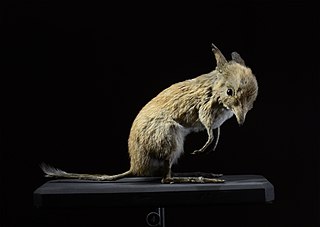 W
WChaeropus, known as the pig-footed bandicoots, is a genus of small mammals that became extinct during the twentieth century. They were unique marsupials, of the order Peramelemorphia, with unusually thin legs yet were able to move rapidly. Two recognised species inhabited dense vegetation on the arid and semi-arid plains of Australia. The genus' distribution range was later reduced to an inland desert region, where it was last recorded in the 1950s; it is now presumed extinct.
 W
WCholoepus is a genus of xenarthran mammals of Central and South America within the monotypic family Choloepodidae, consisting of two-toed sloths. The two species of Choloepus, Linnaeus's two-toed sloth and Hoffmann's two-toed sloth, were formerly believed on the basis of morphological studies to be the only surviving members of the sloth family Megalonychidae, but have now been shown by molecular results to be closest to extinct ground sloths of the family Mylodontidae.
 W
WKitti's hog-nosed bat, also known as the bumblebee bat, is a near-threatened species of bat and the only extant member of the family Craseonycteridae. It occurs in western Thailand and southeast Myanmar, where it occupies limestone caves along rivers.
 W
WA tuco-tuco is a neotropical rodent in the family Ctenomyidae. Tuco-tucos belong to the only living genus of the family Ctenomyidae, Ctenomys, but they include approximately 60 different species. The common name, "tuco-tuco" comes from the "tuc-tuc" sound they make while they dig their burrows.
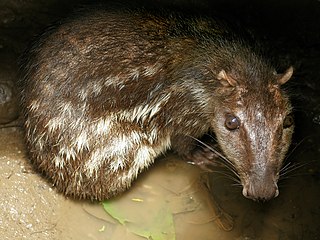 W
WA paca is a member of the genus Cuniculus of ground-dwelling, herbivorous rodents in South and Central America. It is the only genus in the family Cuniculidae. Pacas are large rodents with dots and stripes on their sides, short ears, and barely visible tails. They are also known in Belize as "gibnut" or, having been served to Queen Elizabeth II, as "the royal rat". In the Amazon basin they are known as "majás".
 W
WEnaliarctos is an extinct genus of pinniped, and may represent the ancestor to all pinnipeds. Prior to the discovery of Puijila, the five species in the genus Enaliarctos represented the oldest known pinniped fossils, having been recovered from late Oligocene and early Miocene strata of California and Oregon.
 W
WGypsonictops is an extinct genus of leptictidan mammals of the monotypic family Gypsonictopidae, which was described in 1927 by George Gaylord Simpson. Species in this genus were small mammals and the first representatives of the order Leptictida, that appeared during the Upper Cretaceous.
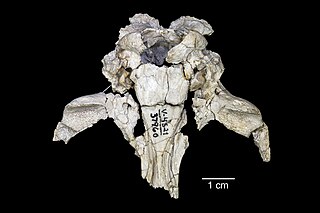 W
WHondadelphys is an extinct genus of carnivorous sparassodonts, known from the Middle Miocene of Colombia. The type species, H. fieldsi, was described in 1976 from the fossil locality of La Venta, which hosts fossils from the Villavieja Formation. Hondadelphys was originally interpreted as belonging to the opossum family Didelphidae, but subsequently assigned to its own family, Hondadelphidae and interpreted as a basal sparassodont. The genus name refers to the Honda Group, the stratigraphic group in which the fossils of this animal were first found, combined with delphys (Greek for "womb", a common suffix used for opossum-like metatherians).
 W
WKollikodon is an extinct species of mammal, it is usually considered to be a member of Australosphenida and closely allied with monotremes, but is alternatively suggested to be a haramiyidan. It is known only from an opalised dentary fragment, with one premolar and two molars in situ, as well as a referred maxillary fragment containing the last premolar and all four molars. The fossils were found in the Griman Creek Formation at Lightning Ridge, New South Wales, Australia, as was Steropodon.
 W
WThe sportive lemurs are the medium-sized primates that make up the family Lepilemuridae. The family consists of only one extant genus, Lepilemur. They are closely related to the other lemurs and exclusively live on the island of Madagascar. For a time, this family was named Megaladapidae, but the current name was given precedence since the extinct genus Megaladapis was removed from the family.
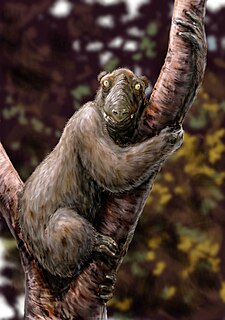 W
WMegaladapis, informally known as the koala lemur, is an extinct genus belonging to the family Megaladapidae, consisting of three extinct species of lemurs that once inhabited the island of Madagascar. The largest measured between 1.3 to 1.5 m in length.
 W
WMiniopterus, known as the bent-winged or long winged bats, is the sole genus of the family Miniopteridae. They are small flying insectivorous mammals, micro-bats of the order Chiroptera, with wings over twice the length of the body. The genus had been placed in its own subfamily among the vespertilionid bats, as Miniopterinae, but is now classified as its own family.
 W
WMoeritherium is an extinct genus of primitive proboscideans. These prehistoric mammals are related to the elephant and, more distantly, sea cows and hyraxes. They lived during the Eocene epoch.
 W
WThe numbat, also known as the noombat or walpurti, is an insectivorous marsupial. It is diurnal and its diet consists almost exclusively of termites.
 W
WNecrolestes is an extinct genus of non-therian mammals, which lived during the Early Miocene in what is now Argentine Patagonia. It contains two species, N. patagonensis and N. mirabilis, and is the most recent known genus of dryolestoid. The type species N. patagonensis was named by Florentino Ameghino in 1891 based on remains found by his brother, Carlos Ameghino in Patagonia. Fossils of Necrolestes have been found in the Sarmiento and Santa Cruz Formations.
 W
WNesophontes, sometimes called West Indies shrews, is the sole genus of the extinct, monotypic mammal family Nesophontidae in the order Eulipotyphla. These animals were small insectivores, about 5 to 15 cm long, with a long slender snout and head and a long tail. They were endemic to the Greater Antilles, in Cuba, Hispaniola, Puerto Rico, the United States Virgin Islands, and the Cayman Islands.
 W
WThe bat family Noctilionidae, commonly known as bulldog bats or fishing bats, is represented by two extant species, the greater and the lesser bulldog bats, as well as at least one fossil species, Noctilio lacrimaelunaris, from the Miocene of Argentina. The naked bulldog bat does not belong to this family, but to the family Molossidae, the free-tailed bats. They are found near water in the Neotropics, from Mexico to Argentina and also in the Caribbean islands. In these areas they can be found roosting in groups within hollow trees, caves, man made homes, or other openings with enough space. While the two species exhibit different social and foraging behaviors both tend to return to a main roosting spot while also visiting other alternative roosting spots.
 W
WNycteris comprises a genus of bats commonly called slit-faced or hollow-faced bats. They are grouped in the family Nycteridae. The bats are found in East Malaysia, Indonesia, and many parts of Africa.
 W
WOcepeia is an extinct genus of afrotherian mammal that lived in present-day Morocco during the middle Paleocene epoch, approximately 60 million years ago. First named and described in 2001, the type species is O. daouiensis from the Selandian stage of Morocco's Ouled Abdoun Basin. A second, larger species, O. grandis, is known from the Thanetian, a slightly younger stage in the same area. In life, the two species are estimated to have weighed about 3.5 kg (7.7 lb) and 10 kg (22 lb), respectively, and are believed to have been specialized leaf-eaters. The fossil skulls of Ocepeia are the oldest known afrotherian skulls, and the best-known of any Paleocene mammal in Africa.
 W
WA pika is a small, mountain-dwelling mammal found in Asia and North America. With short limbs, very round body, an even coat of fur, and no external tail, they resemble their close relative, the rabbit, but with short, rounded ears. The large-eared pika of the Himalayas and nearby mountains is found at heights of more than 6,000 m (20,000 ft), among the highest of any mammal.
 W
WPalaeomastodon an extinct genus of Proboscidea. Palaeomastodon fossils have been found in Africa, lived some 36-35 million years ago. They are believed to be the ancestors of elephants or mastodons. Palaeomastodon lived in marshy semi aquatic swamps during the middle late Eocene to the early Oligocene. It may have used its upper pair of tusks for scraping bark off trees. Palaeomastodon was a very early form of the elephantidae and thus had a very short trunk.
 W
WPappotherium is an extinct genus of mammals from the Albian of Texas, US, known from a fossilized maxilla fragment bearing two tribosphenic molars, discovered within the Glen Rose Formation near Decatur, Wise County, Texas.
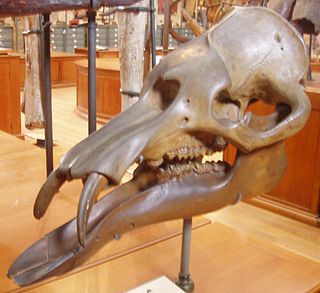 W
WPhiomia is an extinct genus of basal proboscid that lived in what is now Northern Africa during the Late Eocene to Early Oligocene some 37–30 million years ago. "Phiomia serridens" means "saw-toothed animal of Faiyum".
 W
WPlesiorycteropus, also known as the bibymalagasy or Malagasy aardvark, is a recently extinct eutherian mammalian genus from Madagascar. Upon its description in 1895, it was classified with the aardvark, but more recent molecular evidence instead suggests that it is most closely related to the tenrecs. Two species are currently recognized, the larger P. madagascariensis and the smaller P. germainepetterae. They probably overlapped in distribution, as subfossil remains of both species have been found in the same site.
 W
WThe Asiatic linsang (Prionodon) is a genus comprising two species native to Southeast Asia: the banded linsang and the spotted linsang. Prionodon is considered a sister taxon of the Felidae.
 W
WThe pen-tailed treeshrew is a treeshrew of the family Ptilocercidae native to southern Thailand, the Malay Peninsula, Borneo, and some Indonesian islands.
 W
WHorseshoe bats are bats in the family Rhinolophidae. In addition to the single living genus, Rhinolophus, which has about 106 species, the extinct genus Palaeonycteris has been recognized. Horseshoe bats are closely related to the Old World leaf-nosed bats, family Hipposideridae, which have sometimes been included in Rhinolophidae. The horseshoe bats are divided into six subgenera and many species groups. The most recent common ancestor of all horseshoe bats lived 34–40 million years ago, though it is unclear where the geographic roots of the family are, and attempts to determine its biogeography have been indecisive. Their taxonomy is complex, as genetic evidence shows the likely existence of many cryptic species, as well as species recognized as distinct that may have little genetic divergence from previously recognized taxa. They are found in the Old World, mostly in tropical or subtropical areas, including Africa, Asia, Europe, and Oceania.
 W
WMouse-tailed bats are a group of insectivorous microbats of the family Rhinopomatidae with only three to six species, all contained in the single genus Rhinopoma. They are found in the Old World, from North Africa to Thailand and Sumatra, in arid and semiarid regions, roosting in caves, houses and even the Egyptian pyramids. They are relatively small, with a body length of just 5 to 6 cm. They weigh between 6 and 14 g.
 W
WThe honey possum or noolbenger, is a tiny species of marsupial that feeds on the nectar and pollen of a diverse range of flowering plants. Found in southwest Australia, it is an important pollinator for such plants as Banksia attenuata, Banksia coccinea and Adenanthos cuneatus.
 W
WDisk-winged bats are a small group of bats of the family Thyropteridae and genus Thyroptera. They are found in Central and South America, usually in moist tropical rain forests. It is a very small family, consisting of a single genus with five extant and one fossil species.
 W
WVincelestes is an extinct genus of actively mobile mammal, that lived in what would be South America during the Early Cretaceous from 130—112 mya, existing for approximately 18 million years.
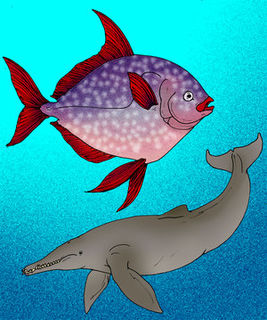 W
WWaipatia is an extinct genus of whale from the late Oligocene (Chattian) of New Zealand.
 W
WZenkerella is a genus of rodent, the only member of the family Zenkerellidae. It was formerly classified in Anomaluridae until phylogenetic studies made its distinctiveness clear.